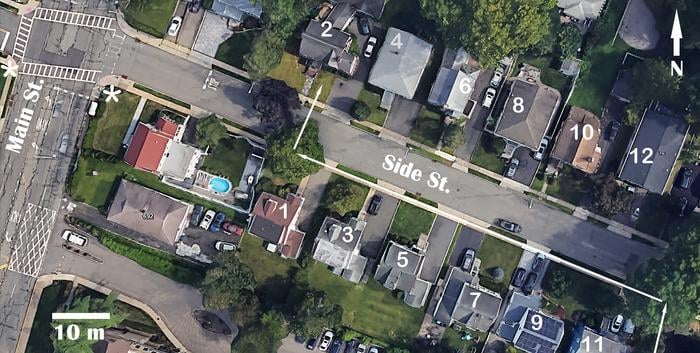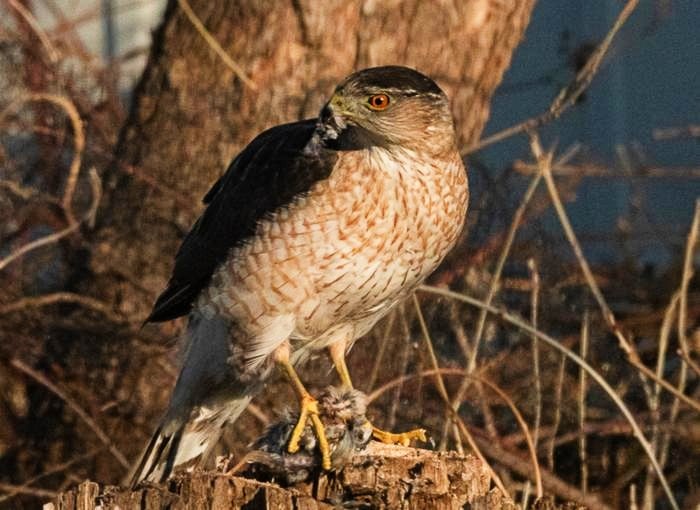A young Cooper’s hawk in New Jersey has learned to decode traffic signals, using the extended red lights triggered by pedestrian crossings as a hunting cue to attack songbirds with military precision.
The remarkable behavior, documented by University of Tennessee researcher Vladimir Dinets, represents the most sophisticated use of human traffic patterns ever recorded in a wild bird. Over 18 observation days, the hawk consistently timed its attacks to coincide with audio signals for blind pedestrians—sounds that predicted longer car queues would provide perfect aerial cover for approaching prey. The discovery challenges assumptions about animal intelligence and reveals how quickly urban wildlife can adapt to complex human-made environments.
The Sound of Opportunity
The breakthrough observation happened at a seemingly ordinary intersection in West Orange, New Jersey. During morning rush hour, cars would queue for red lights, but only briefly—except when pedestrians pressed the crossing button, extending the red phase from 30 to 90 seconds and creating much longer vehicle lines.
What caught Dinets’ attention was the hawk’s uncanny timing. The bird would appear in a strategic tree precisely when audio signals activated for visually impaired pedestrians, well before the extended car queue formed.
The mathematical odds against this being coincidence were staggering. Since the audio signals operated only about 3.75% of the time, the probability of the hawk’s behavior being random was approximately 0.000053—essentially impossible.
Military-Grade Precision
The hunting strategy itself was a masterclass in tactical planning. The hawk would first position itself in a tree near house #11, waiting for the car queue to reach house #8. Only then would it launch its attack, flying 65 meters less than one meter above ground along the sidewalk, making a sharp 90-degree turn, and diving between cars toward prey feeding near house #2.

Credit: Dinets, 2025.
What makes this behavior extraordinary is what the research reveals about the hawk’s cognitive abilities. The bird had to maintain “a precise mental map of the street (as the target flock was invisible to the hawk until the last stage of attack), notice the connection between the sound signals and the length of the car queue, and figure out that only longer queues provided cover for the entire approach.”
Key Behavioral Observations:
- 6 hunting attempts observed over 12 hours of systematic observation
- Hawk appeared during audio signals in all 3 precisely timed observations
- Attack route covered 65 meters at less than 1 meter altitude
- Success required navigating between houses numbered #11 to #2
- Prey included house sparrows, mourning doves, and European starlings
The Learning Curve
Perhaps most impressive was the hawk’s rapid adaptation timeline. Cooper’s hawks rarely nest in the study area and are primarily winter visitors from non-urban environments. This means the observed bird was likely “a very recent immigrant to urban habitat”—yet it had already mastered complex traffic pattern analysis within weeks of arrival.
The research documented an immature bird developing this sophisticated hunting technique, then observed what was likely the same individual returning the following winter as an adult, using identical methods. The continuity suggests this wasn’t accidental learning but deliberate skill development.
The story ended when human infrastructure changed. In summer 2023, the audio signals stopped working and the residents who provided food scraps moved away. Without the acoustic cue and prey concentration, the hawk disappeared—demonstrating how precisely tuned its strategy had become to specific urban conditions.
Beyond Simple Learning
While the behavior might seem like basic conditioning, Dinets argues it represents something far more sophisticated. “The observations presented here could be explained as a result of simple Pavlovian training, but that would be an obvious oversimplification,” he notes in the research.
The hawk’s success required multiple cognitive abilities operating simultaneously: spatial mapping, temporal pattern recognition, acoustic signal interpretation, and predictive planning. The bird had to understand that specific sounds predicted future traffic conditions that would create hunting opportunities minutes later.
This level of environmental analysis goes far beyond typical predator-prey relationships. The hawk essentially learned to read human behavioral patterns and urban infrastructure systems to gain hunting advantages.
Urban Evolution in Real Time
The findings illuminate how rapidly intelligent species can adapt to urban environments. Cooper’s hawks began colonizing cities only in the 1970s, making them relative newcomers to urban hunting. Yet they’ve already developed multiple novel techniques not seen in rural populations.
Previous urban hawk adaptations included hunting from rooftops, using buildings as cover, and foraging under artificial lights. But using traffic control systems represents a quantum leap in environmental manipulation—essentially turning human infrastructure into hunting tools.
The research suggests this intelligence was “likely pre-existing rather than evolved in the novel environment.” This implies that hawks possess cognitive capabilities that simply find new expression in urban settings, raising intriguing questions about untapped animal intelligence in natural habitats.
The Broader Picture
This discovery fits into growing evidence of sophisticated animal behavior in cities. Other birds drop nuts onto roads for cars to crack, ravens patrol highways for roadkill, and small birds use moving vehicles as mobile shelters from predators.
But the Cooper’s hawk’s traffic signal mastery represents “the most advanced case of raptors adapting to use traffic patterns reported to date,” according to the research. It demonstrates that urban environments aren’t just obstacles for wildlife to overcome—they’re complex systems that intelligent animals can learn to exploit.
As cities continue expanding globally, understanding these adaptations becomes crucial for urban planning and wildlife conservation. The hawk’s story suggests that rather than simply displacing nature, human infrastructure might be creating entirely new ecological niches for species smart enough to decode our patterns.
Discover more from Wild Science
Subscribe to get the latest posts sent to your email.

